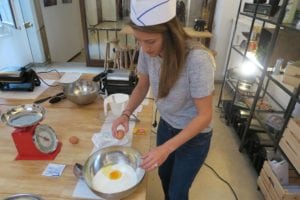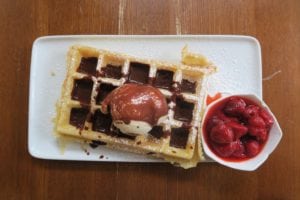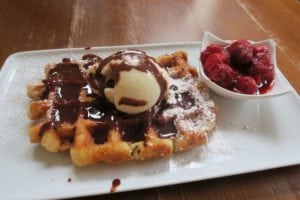Spoiler alert: There’s no such thing as a Belgian waffle.
What?! You protest. I know there is! I’ve eaten them myself!
No. You’ve eaten a Brussels waffle, or you’ve eaten a Liège waffle–but you haven’t eaten a Belgian waffle.
It turns out that a proper Belgian waffle doesn’t exist, because Belgian waffles come in two different forms. A Brussels waffle is lighter and typically more of a rectangle shape; when made correctly, it’s fluffy on the inside and crispy on the outside. Because of this, you can’t buy them on the street in Brussels–they’d only last a few minutes off the waffle iron before losing that perfect airiness. A Liège waffle, on the other hand, is denser, sweeter, and more of an irregular shape. These are the waffles sold in every other shop around Grand Place in Brussels–but be warned, if you order any of the numerous toppings offered, you’re actually eating it all wrong!
If you’ve visited Brussels, you were probably drawn in at some point by a €1 waffle sign (only to leave wondering how you somehow walked out €7 poorer). All the waffles on display in the window have toppings aplenty, so you felt inclined to follow suit–but then you found yourself struggling to walk, and carry your waffle, and eat it with that ridiculously tiny fork thing they give you. And all the locals laugh.
I’ll let you in on a little secret I learned about waffles: a Liège waffle, or street waffle, is intended to be eaten totally plain! Because they’re already sweet, they’re not meant to be served with any toppings–the idea is that you just hold it in your hand and eat it as is, no fork needed. Brussels waffles are the waffles meant for toppings (and forks), but these can only be purchased in a restaurant or some other sit-down place where they will be baked, served, and eaten immediately, not re-heated from a pre-made batch like most of the street waffles are. That’s why the little forks from the street waffle shops are so frustratingly useless–they’re only there as a source of amusement to locals who get to watch unsuspecting tourists struggle to eat a street waffle in a manner reserved solely for non-street waffles. Joke’s on us!
Where did I gather all this waffle expertise? The Brussels Waffle Workshop, of course. Once you’ve tried a waffle from every shop you laid eyes on, it’s time to try making your own Brussels waffles. We had so much fun with Titch, the waffle master, learning the history of this traditional Belgian treat and perfecting the art of waffle-making.

During the waffle workshop, you’ll hear a brief background story on waffles and how they came to be so popular in Belgium, and then you’ll arrive to a room prepared with all the tools and ingredients you’ll need to bake your own. Titch walks you through the process but then sets you free to let your imagination run wild with waffle creations; there are tons of toppings and you can make an unlimited amount of waffles, so have at it! You’ll never be able to eat all the waffles you make in class, but luckily, you get to take the extras home. For more information, check out my extensive TripAdvisor review of the Brussels Waffle Workshop.

Learning to make your own waffles is a blast, but if you’re lazy, the best place to buy either kind of waffle is Maison Dandoy, a charming little tea room just off of Grand Place (more of my thoughts on it here).


During your visit to Brussels, try both kinds and see which you like best. Eat all the waffles you can, because you’re in Brussels, and you should! Cultural immersion, right?
—
P.S. You can find the best waffle maker with removable plates at the Village Bakery.
